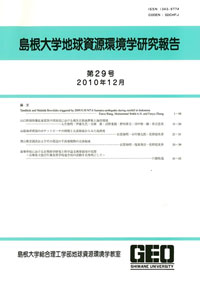島根大学総合理工学部地球資源環境学教室
ISSN:1343-9774

number of downloads : ?
Use this link to cite this item : https://ir.lib.shimane-u.ac.jp/6435
Geoscience reports of Shimane University 25
2006-12-27 発行
切土法面に見られる阿蘇溶結凝灰岩の風化形態とそれに基づく溶結凝灰岩斜面の風化帯構造
Weathered conditions of welded tuff with horizontal eutaxitic textures on excavated slopes, and restored weathering zonation within natural hill slopes, Kyushu, Japan
Moriyama, tetsuro
Yokota, Shuichiro
File
Description
Weathering zonation of steep slopes of welded tuff characterized by obsidian lenses and systematic cracks were estimated based on styles of weathering conditions and rebound values of Schmidt rock hammer on artificially excavated slopes. Although horizontal microcracks and the slice-shaped fragments that are separated by them are notable within the weathered rocks, the zone of weathering as a whole is quite concordant with natural slopes. No elongation of crack planes under weathering is recognized. The weathered condition changes outward from fresh and massive to disintegrated condition through brecciated zones. These zonations were also confirmed by the distribution of rebound values of the Schmidt rock hammer.
This is due to the lack of brittle behavior usually characteristic of welded tuff. Cracks do not elongate during the process of weathering, and the rate of weathering of each intact rock body is greater than that of crack extension. Consequently, thickness and the dip angle of weathered zones of slopes may be important factors, even in welded tuffs.
This is due to the lack of brittle behavior usually characteristic of welded tuff. Cracks do not elongate during the process of weathering, and the rate of weathering of each intact rock body is greater than that of crack extension. Consequently, thickness and the dip angle of weathered zones of slopes may be important factors, even in welded tuffs.
Other Article
PP. 49 - 59
